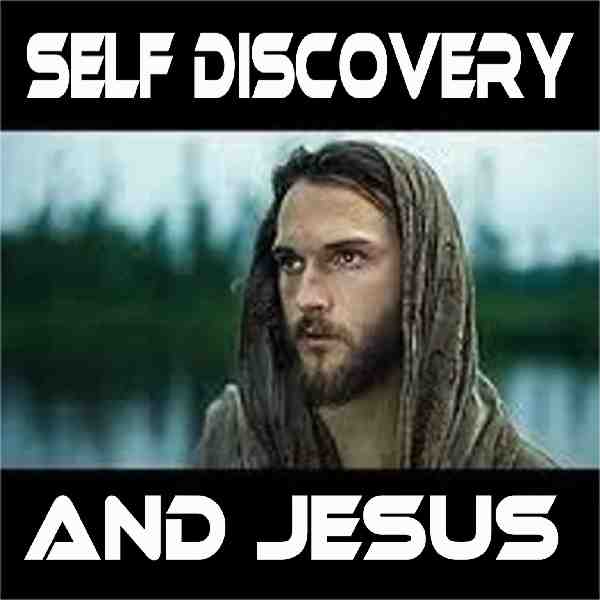"Joseph had a
large family to provide for. Beside Jesus there were four
other boys --- James, Joses, Jude and Simeon. There were also
at least two girls. Joseph had to work hard to feed and to
clothe them all, as well as to pay his taxes both to the Romans and to
his own people. His taxes had to be paid in money, but he
was often paid in kind --- in corn or wine or oil, for example.
Mary did her own spinning and weaving to make clothes, as far as she
could. People wore a cotton undergarment, tunics and cloaks
and sandals on their feet. Men wore their headdress and
women wore veils. Often Mary had to patch the children's torn
clothes."
"The family lived on
home-made bread, fish from the Sea of Galilee, different kinds of fruit,
eggs and milk. Mary had to be a careful housekeeper, for the
family would have little money to spare. The lamb at the
annual Passover Feast was a very special dish --- and a very great
luxury for a peasant home at Nazareth."
"The house was all one
room. It had a raised platform at one end where the
family slept at night. The animals were brought in at night
and tethered below, by the manger. Joseph would have owned
an ass, a goat and chickens and they helped to warm the room at
night. Furniture was simple. There were
earthenware pots for oil and water and grain; a special chest for
clothes and family treasures; millstones for grinding corn; and the
precious oil-lamp which was kept burning day and night in the shadowy,
windowless house. Beds were simply mattresses, rolled up and
stored in a special alcove during the day."
"Jesus often
helped his mother at her tasks -- washing up; sweeping the earthen
floor; grinding corn, heating the oven and making bread; filling,
cleaning and lighting the lamp. He would go with her to the
village well to draw water, Mary gracefully balancing the water-jar on
her head."
"Jesus learnt his
very first word from his mother. It was ABBA -- FATHER, the word
for God that he loved best all of his life. After the evening meal
Joseph took out his precious scroll of Scripture from the
family chest and read to his large family. He would tell
them stories of God's loving care for his chosen people, and of great
heroes of the Jewish faith."
"Every Friday Jesus
joined in the solemn preparation for the sacred Sabbath; and on
the Sabbath day he went with Joseph to take part in the synagogue
service. He would look forward to the great festivals of the
Jewish year -- Passover and Pentecost and Tabernacles, as well as
the other feasts and fasts. For all of them were observed in
the home, and it was there that Jesus learnt to know God."
"Education was
free for Jewish boys from the age of five to thirteen years.
Jesus went with his friends to the synagogue school at
Nazareth. The people of Palestine spoke the Aramaic
language, so the boys had to learn Hebrew -- the ancient language
of their people in which their Scriptures were written."
"The boys sat on the
ground, cross-legged, at school. They wrote in the sand with
their fingers, or sometimes with chalk on the flagstones.
Their text-books were the Jewish Scriptures -- the Christian Old
Testament; school was later called BETH HASEFER --- THE HOUSE OF THE
BOOK. They learned to read the sacred books, to write them
out and to know them by heart. They learnt the important
passages by repeating them over and over again. Every boy
had to learn special texts which began and ended with the first and last
letters of his own name.."
"In the synagogue
school the boys spent all their time learning their Bible, especially
the sacred books of the Law of Moses. Even the alphabet was
learnt from the Law. It was here that Jesus came to know and to
love so well the Jewish Scriptures, for they spoke to him of the
heavenly Father."
"At the synagogue
school at Nazareth Jesus learnt to read and to write. 'Jesus' is
the Greek form of his name. In the language of his people it
was YESHUA.. This is how he would have written it.
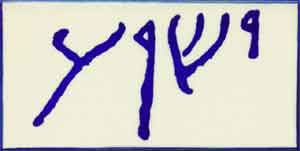
"This writing
was inscribed on a Jewish burial chamber. Yeshua was a
popular name. We do not know who was the Yeshua buried
here. One of the stories in the Gospels mentions Jesus
writing. Read John 8:6-8. Writing in sand was
common. Boys often did this at school."
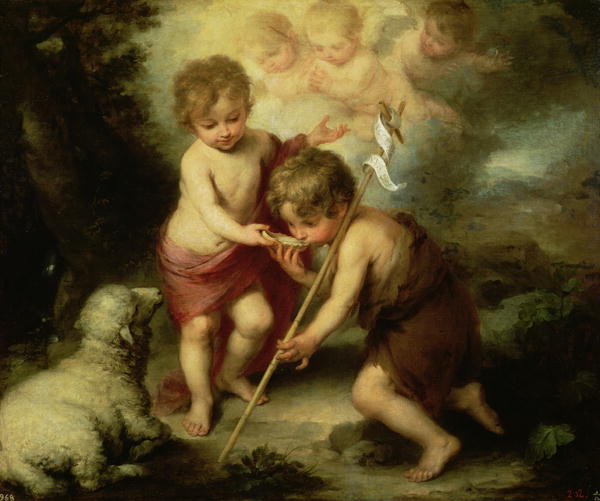
At play
"Jewish children played their games in the
open streets, on the flat roofs of their houses and out in the
fields. Like children today they imitated grown-ups in their
games. They played at mothers and fathers and at weddings
and funerals, with processions and music and dancing."
"Girls had dolls and model animals made of pottery or
clay. Boys made pipes and whistles from reeds or played with
a sling and stones. Everyone played with pebbles. One
game was called GAP -- throwing twelve pebbles in the air and seeing how
many could be caught on the back of the hand. Another was
like hop-scotch. Children played it on the flat roof of the
house which was surrounded by a parapet so that no one could fall
off. They drew squares and numbered them and then threw
pebbles into the squares, one after another."
At work
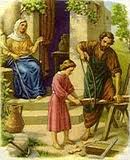
"Jesus had to
work, too. The Jews had a saying -- 'If a man does not teach
his son a trade he teaches him to be a robber.' Fathers usually
taught their own trade to their sons. Jesus learnt to be a woodworker.
He would help Joseph to make yokes and ploughs for the farm,
chests and stools and cradles for the home, doors and roof-beams and
window-frames for new houses."
"Jesus was well
taught by Joseph and he became skilled in his craft. When
Joseph died, Jesus took over his business. That was why everyone
knew him as JESUS THE WOOD-WORKER when he was grown up. Rich
and important Jews, such as the Sadducees, looked down on humble
craftsmen like wood-workers. Many Pharisees were carpenters
and other such workers. They sneered at this wood-worker
of Nazareth, setting himself up as a Rabbi."
Out of Doors
"Nazareth
lay in the lap of the hills of Lower Galilee. Jesus had only
to climb the hill to see far into the distance in all directions.
To the north he could see snow-capped Mount Hermon. To the west
was Mount Carmel. To the east lay the Jordan valley. To the
south he looked over the great Roman road from Caesarea to
Damascus, with its constant stream of travellers -- soldiers, merchants,
kings, camel caravans and well-laden asses, pilgrims and beggars."
"Jesus loved to be out on the hills. In the wild flowers he
saw God's beauty: in the birds of the air he saw God's loving care for
every living creature. As he lay still on the grass he watched the
bird returning to its nest, the eagle swooping on its prey, the fox
creeping back to its hole."
"Sometimes
he went to the farms of his friends. He watched the workers
scattering the seed, reaping and winnowing; he noticed how rich men
stuffed their barns full to overflowing. He saw the mother hen
tenderly sheltering her chicks under her wings. He helped the
farmer to pull out an ox fallen into a pit."
"Perhaps he
loved best to be up on the hills with the shepherds, for he often spoke
of them in his teaching. He knew the difference between the
true shepherd and the hired man. The shepherd knew and loved
each single one of his flock, just as they knew him and answered only to
his voice. It was the hired man who fled when the ravenous
wolf threatened the flock. He knew how the true shepherd
after counting his sheep at night and seeing them safely into the fold,
would go back and search for even one lost lamb. And when he
had brought it back, rejoicing, he would lie across the entrance to the
fold all night. He himself was the door, keeping out wild
beasts. So, by both night and day, the good shepherd guarded his
flock, ready to defend them with his own life."
"Jesus loved, too, to be with his friends the fishermen by the Sea
of Galilee. He grew up with their sons. He
helped them mend the torn nets, wash away the filth of the sea, and sort
out the heaving catch. They learnt to know Jesus, too. When
the day came that he called them they gladly left everything and
followed him."
"In
the market-place and the streets of Nazareth Jesus saw all kinds of
people. He listened to the open-air law court, learning how
men's ways differed from God's ways. He saw the hawk-eyed
traders, cheating as they measured the corn; ragged beggars, crying out
for alms; noisy news-mongers with tidings of happenings throughout the
land; great teachers and wise men preaching in the market-place;
hypocrites making a show of their learning; tax-collectors piling up
coins at the custom-seat; merchants bargaining for a good sale, with
dishonest oaths; blind men led by kindly friends. Even a boy
could listen to what was being said. Jesus heard stories of
travellers waylaid and robbed, of unjust judges and of dishonest
stewards; of foolish sons who went off to waste their father's
hard-earned money."
"Jesus
grew up like any other Jewish boy -- at home, at school, at work
and at play. When he was a man, teaching about God, he spoke to
the people of things they knew and understood and made up stories about
daily life. That is why we learn so much about his boyhood from
his teaching."
|
Doctor Norman Bull, MA, PhD, author of school books for public
school children for Hutton Books, of Great Britain, is
trying here to present a believable Jesus for everyone, not the
"Divine Child" of the Latin Infancy Gospel, nor the
"Miracle-working Child" of the Apocryphal Infancy Gospel
of Thomas, nor even the "Perfect Child and Youth" of
Ellen White's 1888-1898 presentation in Desire of Ages. A
Jesus that Ellen White is imagining was contemplating his mission
to became a bleeding lamb sacrifice for the whole world at twelve
years old!
Noting
that Jesus' father Joseph and Jesus himself are called
"Wood-workers" (Carpenters) in two of the four gospels,
and that Mary is taking care of 7 children (4 boys and 2 girls
besides Jesus) Professor Bull assumes logically that Jesus, the
firstborn of this menagerie, must have taken over the family
business and provided a living for everyone else up till the time
of his baptism by John the Baptist, at which time one or several
of Joseph's other sons was old enough and talented enough to take
over this same "Carpenter" business and support the
family while Jesus left to preach his own version of the
"Good News for All Jews." |
The first visit to
Jerusalem Page 78
"Doctor Luke tells us the only story we have in the Bible of
Jesus as a boy.. At the age of thirteen years a Jewish boy left
school. Still today a Jewish boy has his BAR MITZVAH, his coming
of age, at this time. By this ceremony he becomes a SON OF THE
LAW. Now he is regarded as an adult Jew. He is
expected to recite the great prayer HEAR O ISRAEL twice a day; to
fast on the appointed days; to keep the feasts; to attend the synagogue;
to go as a pilgrim to Jerusalem, and generally to accept the
responsibility for bhis own behavior."
"When
Jesus left school and came of age he was ready to make his first
pilgrimage to Jerusalem. Joseph and Mary took him with them for
the greatest feast of the year -- the Passover, in the
spring. There, with the other boys of his age, he would be
questioned and tested by leading teachers."
|
Here Professor Bull mentions, without comment, the distance
between Nazareth and Jerusalem, 128 KM, about 2 hours drive by
modern car on good roads under ideal traffic conditions. But
by normal walking speeds of 2-3 miles per hour plus frequent
breaks perhaps a 7 to 10 days journey. with the Biblical
assumption that it would take three days to make this journey.
This is one of several ways that Dr. Barbara Thiering in 1992 was
able to convince some of us that the "Nazareth" of
Jesus' era was at Mar Saba, a mere 7 miles from
Jerusalem. Not in far-away Galilee. |
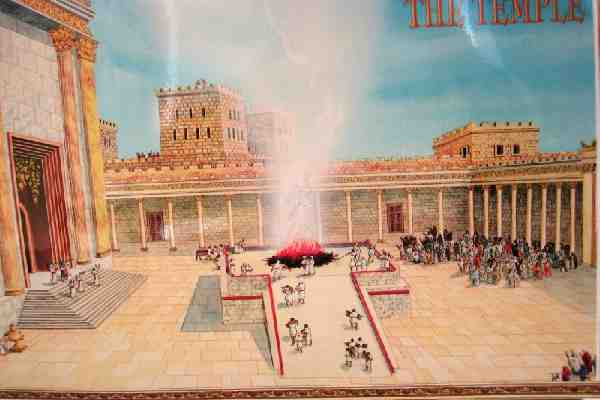
"The journey of 128
km to Jerusalem took three days. They traveled with friends and
relatives from Nazareth in a caravan for safety and company, camping by
night. Jesus must have been entralled by what he saw at Jerusalem,
above all at the temple of God, for on the way home Mary and Joseph
found that he was missing. They had thaought he was with his
friends, but he was nowhere to be found. Anxiously they hurried
back to Jerusalem. There at last they found him.
He was still with the Rabbis, seeking answers to questions that puzzled
him. They were astonished by his knowledge and understanding of
the Scriptures and by the questions which he asked. Mary
spoke crossly to her son for being so thoughtless and giving his parents
such a lot of worry. 'But why were you searching for me?' Jesus
said to her, 'Didn't you realize that I would be in my Father's
house?'"
"Luke's story shows us
that already, even as a boy, Jesus was completely dedicated to
God."
The silent years
"Jesus went back home to Nazareth with Joseph
and Mary. He was a good son, obedient and dutiful. The
next we hear of Jesus is when he left home at Nazareth to begin his work
for God. He was then about thirty years old. We know
nothing about him from the age of twelve to the age of thirty. We
call these THE SILENT YEARS. What was Jesus doing during that
time?"
"Some
Jewish boys went on to study at Jerusalem after they left the local
synagogue school. They were usually boys who were going to become
Rabbis. At Jerusalem they were taught by the great Doctors
of the Law. One of them was Paul who was proud of having been
taught by the famous Rabbi Gamaliel. It was like going to a
university. But it was very expensive. Paul came
from a wealthy home. Jesus came from a village wood-worker's
home. We can be certain that there was no money for Jesus to study
at Jerusalem. But we can be sure that he went to Jerusalem
each year for the Passover as a pilgrim."
"What then was Jesus doing during the Silent Years?"
"When he began to preach at Nazareth the people said, 'Why this is
Yeshua bar Joseph the wood-worker!" They knew him well
enough. So we can be sure that Jesus was at Nazareth during those
years. Joseph was not mentioned again when Jesus began to
teach. He must have died when Jesus was a young man.
Jesus had taken over Joseph's shop. He too had to work hard
to provide for his widowed mother and her other six children.
He did not have to leave home until they were old enough to care for
Mary, and until the time had come for him to preach the kingdom of
God."
|
"The Kingdom of God in
the Wilderness"
Norman Bull, M.A.,
PhD
"Jesus the
Nazarene" page 38
"Some
Jews lived alone all their lives. These monks werre called
ESSENES -- PIUS ONES. Ancient writers described how they
lived in the bleak and blazing desert at Engedi, near the Dead
Sea -- 'with only palm trees for company,' one of them wrote.
"
"Nothing else was known about these monks till 1947.
In that year a goatherd by chance found earthenware jars in a lonely
cave up on the cliff by the Dead Sea. In them were leather
scrolls wrapped in cloth. They are the famous DEAD SEA SCROLLS,
a complete library of ancient books. Scholars found among them
many books of the Old Testament as well as other writings.
They are very precious, for they are 1,000 years older than all our
other manuscripts of the Old Testament."
"But whose library
was this? In 1951 scholars dug up the ancient ruins at the foot
of the cliff by the Dead Sea called KHIRBET QUMRAN. They found the
remains of the monastery where the Essenes had lived
together. The library of books must have been
theirs."
"Why had they hidden
them? The Essenes had lived in the monastery by the Dead Sea for
over 100 years when the Zealots started the last war against
Rome. In CE 68 the monastery was captured by Roman troops and
the monks were killed or scattered. But they had time to hide
their precious library safely in the caves where it was found almost
1900 years later."
"from Qumran, the home
of these Essenes, groups of monks went out to set up other lonely
monasteries. They called themselves THE COMMUNITY, for
they lived as brothers, sharing everything, eating communal meals, and
praying together at the appointed times. They worked hard to
support themselves and fed only on the vegetables they grew. Each
monk promised to be obedient to the rule of the Community, to
remain unmarried, and to own nothing of his own. Some Essenes
lived quite alone. John the Baptist may have been one of
these."
"The Essenes were
devoted to the Law of God which they kept strictly. Led by
their priests, they had ceremonies of washing as symbols of their
inner purity. Their simple white garment of linen cloth was a
symbol of the good life to which they were dedicated."
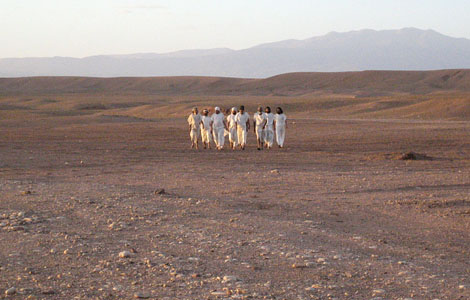
NEXT:
"Essene Child at Qumran and Mar Saba
|
